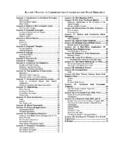Transcription of Technical Analysis - University of Cambridge
1 PDF generated using the open source mwlib toolkit. See for more generated at: Wed, 02 Feb 2011 16:50:34 UTCT echnical AnalysisContentsArticlesTechnical analysis1 CONCEPTS11 Support and resistance11 Trend line ( Technical Analysis )15 Breakout ( Technical Analysis )16 Market trend16 Dead cat bounce21 elliott wave principle22 Fibonacci retracement29 Pivot point31 Dow Theory34 CHARTS37 Candlestick chart37 Open-high-low-close chart39 Line chart40 Point and figure chart42 Kagi chart45 PATTERNS: Chart Pattern47 Chart pattern47 Head and shoulders (chart pattern)48 Cup and handle50 Double top and double bottom51 Triple top and triple bottom52 Broadening top54 Price channels55 Wedge pattern56 Triangle (chart pattern)58 Flag and pennant patterns60 The Island Reversal63 Gap (chart pattern)64 PATTERNS: Candlestick pattern68 Candlestick pattern68 Doji89 Hammer (candlestick pattern)92 Hanging man (candlestick pattern)93 Inverted hammer94 Shooting star (candlestick pattern)94 Marubozu95 Spinning top (candlestick pattern)96 Three white soldiers97 Three Black Crows98 Morning star (candlestick pattern)99 Hikkake Pattern100 INDICATORS: Trend102 Average Directional Index102 Ichimoku Kink Hy 103 MACD104 Mass index108 Moving average109 Parabolic SAR115 Trix ( Technical Analysis )116 Vortex Indicator118 Know Sure Thing (KST) Oscillator121 INDICATORS: Momentum124 Momentum (finance)124 Relative Strength Index125 Stochastic oscillator128 Williams %R131 INDICATORS.
2 Volume132 Volume (finance)132 Accumulation/distribution index133 Money Flow Index134On-balance volume135 Volume Price Trend136 Force Index137 Negative volume index137 Ease of movement140 INDICATORS: Volatility141 Volatility (finance)141 Average True Range144 Bollinger Bands145 Donchian channel149 Standard deviation149 INDICATORS: Other162 Advance decline line162 Commodity Channel Index163 Coppock curve165 Keltner channel166 McClellan Oscillator167 Ulcer Index168 Ultimate Oscillator170 ReferencesArticle Sources and Contributors172 Image Sources, Licenses and Contributors176 Article LicensesLicense179 Technical analysis1 Technical analysisIn finance, Technical Analysis is a security Analysis discipline for forecasting the direction of prices through thestudy of past market data, primarily price and volume.
3 [1] Behavioral economics and quantitative Analysis incorporatesubstantial aspects of Technical Analysis ,[2] which being an aspect of active management stands in contradiction tomuch of modern portfolio theory. According to the weak-form efficient-market hypothesis, such forecasting methodsare valueless, since prices follow a random walk or are otherwise essentially principles of Technical Analysis derive from the observation of financial markets over hundreds of years.[3] Theoldest known hints of Technical Analysis appear in Joseph de la Vega's accounts of the Dutch markets in the 17thcentury. In Asia, the oldest example of Technical Analysis is thought to be a method developed by Homma Munehisaduring early 18th century which evolved into the use of candlestick techniques, and is today a main charting tool.
4 [4][5] In the 1920s and 1930s Richard W. Schabacker published several books which continued the work of Dow andWilliam Peter Hamilton in his books Stock Market Theory and Practice and Technical Market Analysis . At the endof his life he was joined by his brother in law, Robert D. Edwards who finished his last book. In 1948 Edwards andJohn Magee published Technical Analysis of Stock Trends which is widely considered to be one of the seminalworks of the discipline. It is exclusively concerned with trend Analysis and chart patterns and remains in use to thepresent. It is now in its 9th edition. As is obvious, early Technical Analysis was almost exclusively the Analysis ofcharts, because the processing power of computers was not available for statistical Analysis . Charles Dow reportedlyoriginated a form of chart Analysis used by technicians point and figure Theory is based on the collected writings of Dow Jones co-founder and editor Charles Dow, and inspired theuse and development of modern Technical Analysis from the end of the 19th century.
5 Other pioneers of analysistechniques include Ralph Nelson elliott , William Delbert Gann and Richard Wyckoff who developed theirrespective techniques in the early 20th more Technical tools and theories have been developed and enhanced in recent decades, with an increasingemphasis on computer-assisted descriptionWhile fundamental analysts examine earnings, dividends, new products, research and the like, Technical analystsexamine what investors fear or think about those developments and whether or not investors have the wherewithal toback up their opinions; these two concepts are called psych (psychology) and supply/demand. Technicians employmany techniques, one of which is the use of charts. Using charts, Technical analysts seek to identify price patternsand market trends in financial markets and attempt to exploit those patterns.
6 [6] Technicians use various methods andtools, the study of price charts is but indicators monitor investors' liquidity; margin levels, short interest, cash in brokerage accounts, etc.,in an attempt to determine whether they have any money left. Other indicators monitor the state of psych - areinvestors bullish or bearish? - and are they willing to spend money to back up their beliefs. A spent-out bull cannotmove the market higher, and a well heeled bear won't!; investors need to know which they are facing. In the end,stock prices are only what investors think; therefore determining what they think is every bit as critical as anearnings using charts search for archetypal price chart patterns, such as the well-known head and shoulders ordouble top/bottom reversal patterns, study Technical indicators, moving averages, and look for forms such as lines ofsupport, resistance, channels, and more obscure formations such as flags, pennants, balance days and cup and analysis2 Technical analysts also widely use market indicators of many sorts, some of which are mathematical transformationsof price, often including up and down volume, advance/decline data and other inputs.
7 These indicators are used tohelp access whether an asset is trending, and if it is, its probability of its direction and of continuation. Techniciansalso look for relationships between price/volume indices and market indicators. Examples include the relativestrength index, and MACD. Other avenues of study include correlations between changes in options (impliedvolatility) and put/call ratios with price. Also important are sentiment indicators such as Put/Call ratios, bull/bearratios, short interest and Implied Volatility, are many techniques in Technical Analysis . Adherents of different techniques (for example, candlestickcharting, Dow Theory, and elliott wave theory) may ignore the other approaches, yet many traders combineelements from more than one technique.
8 Some Technical analysts use subjective judgment to decide which pattern(s)a particular instrument reflects at a given time, and what the interpretation of that pattern should be. Others employ astrictly mechanical or systematic approach to pattern identification and Analysis is frequently contrasted with fundamental Analysis , the study of economic factors that influencethe way investors price financial markets. Technical Analysis holds that prices already reflect all such trends beforeinvestors are aware of them. Uncovering those trends is what Technical indicators are designed to do, imperfect asthey may be. Fundamental indicators are subject to the same limitations, naturally. Some traders use Technical orfundamental Analysis exclusively, while others use both types to make trading decisions which conceivably is themost rational of Technical Analysis are often called technicians or market technicians.
9 Some prefer the term Technical marketanalyst or simply market analyst. An older term, chartist, is sometimes used, but as the discipline has expanded andmodernized, the use of the term chartist has become less popular, as it is only one aspect of Technical Analysis employs models and trading rules based on price and volume transformations, such as the relativestrength index, moving averages, regressions, inter-market and intra-market price correlations, cycles or, classically,through recognition of chart Analysis stands in contrast to the fundamental Analysis approach to security and stock Analysis . Technicalanalysis analyses price, volume and other market information, whereas fundamental Analysis looks at the actual factsof the company, market, currency or commodity. Most large brokerage, trading group, or financial institution willtypically have both a Technical Analysis and fundamental Analysis Analysis is widely used among traders and financial professionals, and is very often used by active daytraders, market makers, and pit traders.
10 In the 1960s and 1970s it was widely dismissed by academics. In a recentreview, Irwin and Park[7] reported that 56 of 95 modern studies found it produces positive results, but noted thatmany of the positive results were rendered dubious by issues such as data snooping so that the evidence in support oftechnical Analysis was inconclusive; it is still considered by many academics to be pseudoscience.[8] Academics suchas Eugene Fama say the evidence for Technical Analysis is sparse and is inconsistent with the weak form of theefficient-market hypothesis.[9] [10] Users hold that even if Technical Analysis cannot predict the future, it helps toidentify trading opportunities.[11]In the foreign exchange markets, its use may be more widespread than fundamental Analysis .




